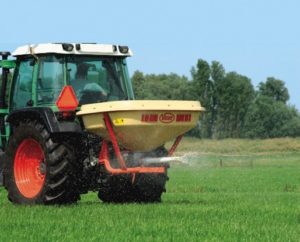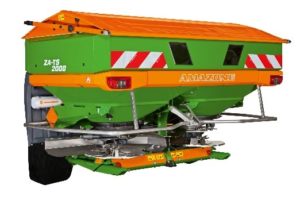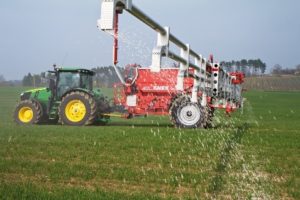Spreading
Types of spreading systems
There are different spreading systems, each with its own advantages and disadvantages. Each system has specific features such as spreading pattern, user-friendly design and maintenance

Pendulum spreader
A pendulum spreader is a fertiliser spreader with a spreading spout that moves from left to right. This determines the fertiliser rate and ensures the fertiliser has a wide spread.
Spreading width depends on spout length, drive speed and stroke length.
Pendulum spreaders are designed either as mounted or trailed versions. Currently, there is only one manufacturer of pendulum spreaders. These spreaders are particularly popular in the livestock industry.
Their advantage is that they almost always give a good spreading pattern, regardless of the quality of the mineral fertiliser. So a reasonably good spreading pattern can still be achieved with a poor quality fertiliser. In addition, wind influence on this spreader is insignificant. A disadvantage of this system is that the working width is limited.
Disc spreader (centrifugal spreader)

A centrifugal spreader is equipped with one or two spreader discs.
The discs are fitted with vanes.
The working width mainly depends on the speed of the vanes and where the granule lands on the disc. It is difficult to get a symmetrical spreading pattern with a single-disc spreader, because the fertiliser does not fall into the centre of the disc. A twin-disc spreader has an even spreading pattern and therefore spreads more accurately. A disc spreader can achieve a wider working width than a pendulum spreader.
Compared with the pendulum spreader and the pneumatic spreader, the disc spreader is the most seriously affected by wind and fertiliser quality, particularly disc spreaders with a wide working width.
Pneumatic spreader

Like the pendulum spreader, the pneumatic spreader can spread lower-quality fertilisers very accurately. This is the main advantage of a pneumatic spreader. In addition, a pneumatic spreader is unaffected by wind and weather conditions and slopes. A pneumatic spreader can also spread very precisely along field boundaries.
Unlike pendulum or disc spreaders, pneumatic spreaders have a fixed spreading and working width. This is one of the disadvantages of this system. Other disadvantages are that it is very high-maintenance, expensive and complicated.
Spreader drive
Certain parts of a spreader can be driven in different ways. For example, the discs can be hydraulically or mechanically driven. With a mechanical drive, the discs are driven by the power take-off. In a hydraulic system, the discs are driven by hydraulics.
The advantages of a hydraulic system are:
- The speed (rpm) is independent of the tractor speed. Engine speed is not linked to disc speed, so the speed remains the same;
- No power take-off is needed;
- The spreader can be connected quickly;
- Work can be done at lower speeds, saving fuel.
The above advantages of the hydraulic system can be considered a disadvantage when a mechanically driven spreader is used.
The disadvantages of a hydraulic system are:
- Expensive system;
- Slow response when changing engine speed;
- The tractor must have a large oil delivery capacity. The system depends on the oil temperature.
The advantages of a mechanical spreader are:
- Direct drive;
- Sustainable, proven technology;
- Easy to use;
- Can also be used with a small tractor;
- It is easy to set a fixed speed for a good spreading pattern.
More and more spreaders with electronically driven systems will be coming on to the market in future. These include electronic control of dosing slides and an electrically driven agitator.
The advantage of the systems is that they operate independently of tractor speed or oil temperature, like a hydraulic system. One disadvantage is that these spreaders cannot be connected to every tractor.
Source:
Blanken, Middelkoop, Ouweltjes, Remmelink, & Wemmenhove, 2011.
Blanken, 2011.
Rauch, 2014.
Turenhout, 2014.
Roelofs, 2014.


